Spring 2020
Jonathan Ochshorn
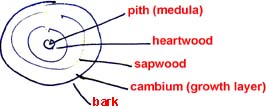
The primary structural element of the wood consists of long strands of cellulose, running longitudinally up the tree: C6H10O5. These "straw-like" cellular structures are cemented together by lignin. Wood is strongest in the direction of these cells (longitudinally), and relatively weak perpendicular to this "grain."
The rings evident in the cross section correspond to alternating periods of rapid (spring) and slower (summer) growth.
Wood is classified into two main types:
Softwoods are most commonly used as structural lumber in the US. Common species include Douglas Fir, Southern Pine, or combinations with similar structural properties such as Spruce-Pine-Fir.
Moisture: wood is sensitive to gains and losses of moisture; it is filled with water when alive, and begins to lose water after being cut, so as to equilibrate its internal moisture content with the ambient humidity. Moisture content [MC] is defined as (weight of water in the wood) / (dry weight of the wood) and expressed as a percentage. Less than MC = 19% constitutes "dry" lumber, i.e., lumber that has been "seasoned" through air- or kiln-drying. Air drying takes several months (and results in MC = 15-18%) versus kiln drying which only takes several days (and results in MC = 8-11%). Moisture is often added during kiln drying to control the rate of evaporation, in order to reduce the splitting, checking, etc. that would otherwise occur under rapid, uncontrolled drying. Moisture content [MC] greater or equal to 19% constitutes "green" lumber. In ordinary applications, it is unwise to use green lumber, as it will shrink, and possibly warp, as it accommodates itself to the ambient humidity characteristic of normal occupancies. For most modern construction, kiln-dried lumber is used. Note that the strength of wood is reduced somewhat when used green, compared to when it is dry.
Warping: Wood is most stable parallel to grain, i.e., along its longitudinal axis corresponding to the vertical orientation of the living tree trunk. It is least dimensionally stable along its so-called "tangential" axes, as shown in the sketch below. Radial shrinkage is about 1/2 that of shrinkage in the tangential direction. Note that such shrinkage (and expansion) corresponds to the loss (or gain) of moisture.
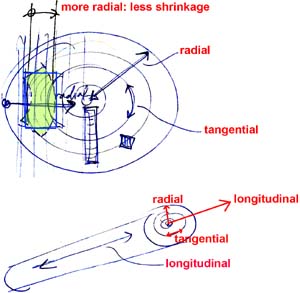
As can be seen, rectangular cross-sections may have a tendency to warp if two opposite faces have different orientations with respect to the "tangential" direction.
Detailing to account for shrinkage: Because wood shrinks more perpendicular to its grain, buildings should be configured so that all lines of structure have more-or-less equal amounts of shrinkage (i.e., equal dimensions of wood perpendicular to grain). In the sketch below, the mezzanine intersects one line of structure with wood oriented perpendicular to the vertical lines of force. This side of the building would be expected to shrink more than the other side, resulting in an unintended slope to the floor or roof above.
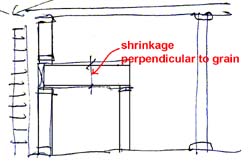
Cutting lumber to reduce warping: Lumber can be quarter-sawn to minimize warping, but such a process is inefficient and can be wasteful, although it provides the most stable boards. Such wood may be used for cabinetry, or other applications where precision is required, but is not used for ordinary structural lumber. Ordinary structural lumber, typically covered by interior and exterior finishes, does not require the same degree of precision, and is plain-sawn.
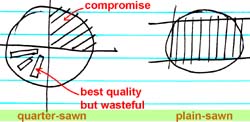
Decay: Wood may decay in the presence of wood-eating organisms (fungus) which require the following things in order to operate:
It is usually easiest to remove the water from the wood, and thereby protect it from decay. This is done primarily through good detailing practice (e.g., sloping all nearly-horizontal surfaces, as in a "wash" detail, so the water doesn't remain in contact with the wood; sloping the grade away from the building on all sides; covering soil under crawl spaces with a moisture barrier; using pressure-treated [PT] lumber where it is within about 18" of the soil; and protecting the surface of the wood with coatings such as paint.
Fire: Wood is combustible and is not permitted in certain types of construction (see fire safety section of course). However, fire-retardant chemicals can be injected into the wood, allowing it to be used in certain non-structural applications, even in Types I and II construction. Heavy timber construction has a greater resistance to fire damage because of the thickness of individual members: a "char" layer forms on the outside of the cross-section that protects the inner part from damage.
Grading: Wood is classified first by species, and then by size and grade. The size classifications are:
The actual sizes of lumber differ from the nominal sizes as follows*:
| Some examples: | nominal size | actual size |  |
| 2x4 | 1-1/2" x 3-1/2" | ||
| 2x10 | 1-1/2" x 9-1/4" | ||
| 4x6 | 3-1/2" x 5-1/2" | ||
| 4x8 | 3-1/2" x 7-1/4" | ||
| 6x6 | 5-1/2" x 5-1/2" | ||
| 6x10 | 5-1/2" x 9-1/4" | ||
| 6x18 | 5-1/2" x 17" | ||
| 8x20 | 7-1/4" x 19" | ||
| 16x18 | 15" x 17" |
* These dimensioning rules are from the 2012 National Design Specification for Wood Construction (NDS) Supplement and represent a change from previous values.
It should be noted that most nominal dimensions are in 2" increments; there are some exceptions such as 2x3s or special lumber used in wooden trusses, such as 2x5s.
Since much older wood is in circulation, here is a summary of the size rules from the 2005 and 2012 NDS:
| Wood sizes: "dressed" (actual) sizes of sawn lumber, dry. |
Old rules (2005 NDS): New rules (2012 NDS): |
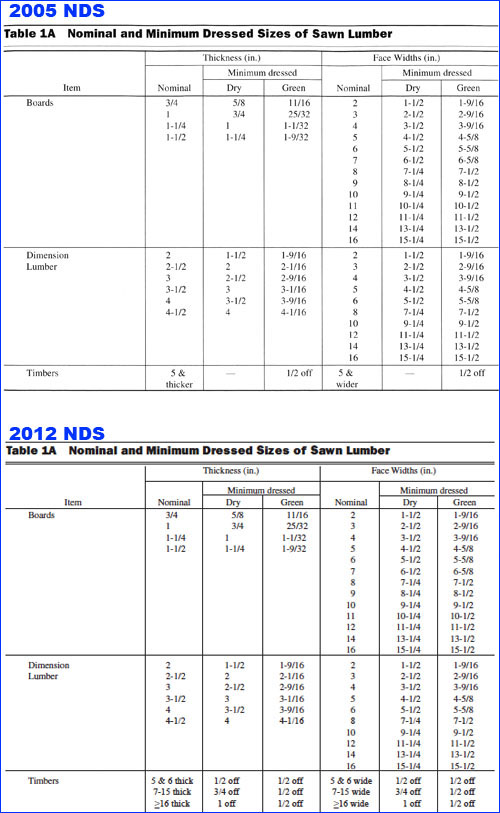
The grades for lumber are determined by visual inspection (visually-graded), by machine testing (machine stress-rated), or by combinations of these two methods. The grades account for imperfections in the lumber which would reduce their strength and stiffness. These imperfections include knots (where branches have intersected the longitudinal fibers), and various types of splits, checks, and so on (these are imperfections that result in separations within the wood grain). Typical grade nomenclature consists of, from best to worse:
Other specialized grades have also been developed, such as "stud grade" for vertical elements used in walls, "construction grade" and "utility grade." For each grade, the industry publishes structural information (allowable stresses). See Span calculator for joists and rafters for examples of species and grades.
Connections:
The size of nails is indicated by the designation "penny," derived from the biblical use of "denarius" which was the historical equivalent of today's penny (or the British pence, who knows?). In any case, we use the abbreviation "d" to stand for "penny" and say "10-penny nail" when reading "10d nail." This designation once related to the cost of 100 nails; today it simply indicates size: 2d = 1", 20d = 4", 60d = 6", and so on. Nails work best in shear (face nailing), where the nail is driven into (perpendicular to) the grain of the wood. End nailing is not recommended, since the nail can easily pull-out in tension; toe nailing is somewhere between face and end nailing, and is often used when no other nailing strategy is feasible.
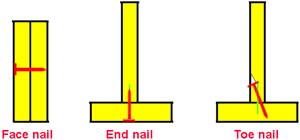
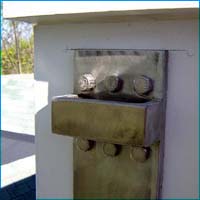
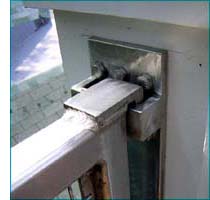
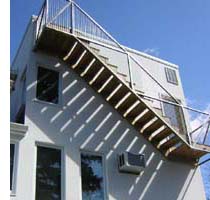

Another type of metal fastener is the split ring, used in heavier construction (especially wooden trusses), where the shear force between members is large, and the transfer of such forces is accomplished with a circular ring, typically of 2-1/2" or 4" diameter, inserted into pre-"dapped" grooves in the overlapping wooden members, which are then bolted together to hold them in place. It is the circular ring, not the bolt, that actually transfers the forces.
Other wood products:
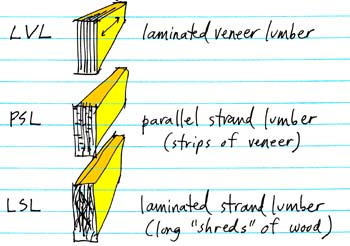

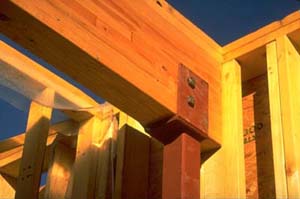
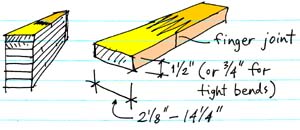
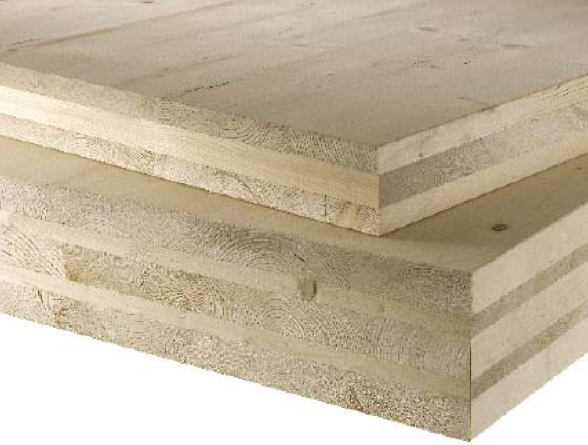
Disclaimer: Students are responsible for material presented in class, and required material described on course outline. These notes are provided as a tentative outline of material intended to be presented in lectures only; they may not cover all material, and they may contain information not actually presented. Notes may be updated each year, and may or may not not apply to non-current versions of course.
first posted Aug. 24, 2007 | last updated: Feb. 1, 2016
Copyright
2007-2013 J. Ochshorn. All rights reserved. Republishing material on this web site, whether in print or on another web site, in whole or in part, is not permitted without advance permission of the author.